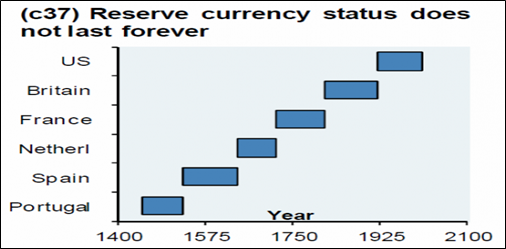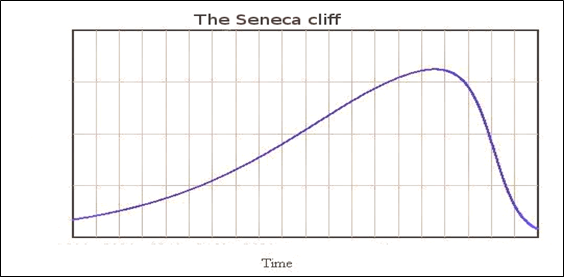Collapsism
“If something cannot go on forever, it will stop”
Stein’s Law
Rises and falls of great powers
Great powers are the key players in international relations. Therefore, the destinies of empires / hegemons / unipoles are so important to follow up and examine in details. Two classical documents on the subject “collapsing of great power” (Paul Kennedy 1989 and Joseph Tainter 1988), among others, will be used as a theoretical base and comparable “benchmark” in assessing the prevailing situation in the international politics.
Kennedy’s book focuses on national and international powers in the post-Renaissance period.
It concerns itself with major wars, changes in global economic balances and especially in the interaction between economies and strategies of leading states in the international system. The military conflict is always examined in the context of economic change.
One of his key arguments is that the relative strengths of the leading nations in world affairs never remain constant. Once their productive capacity was enhanced, countries would find it easier to sustain the burdens of paying for large-scale armaments and supplying large armies and fleets in wartime. Wealth is usually needed to underpin military power and military power is usually needed to acquire and protect wealth.
If however, too large proportion of the state’s resources is diverted from wealth creation and allocated instead to military purposes it may lead to a weakening national power over the long term. If the state overextends itself strategically (e.g. waging of very costly wars), it runs the risk that potential benefits from external expansion may be outweighed by the greater expense of it all. This dilemma may become acute if the nation has entered a period of relative economic decline.
The dynamics of technological change and economic growth as well as national incentives for their promotion and utilization have always created uneven growth rates among states and therefore made the international system unstable and complex increasing propensity to military competitiveness.
Based on the historical evidence, Kennedy argues for a causal relationship between economic and productive growth and the position occupied by the particular great power in the international system. Similarly, the historical record suggests the strong relationship between an individual great power’s economic rise and fall and its growth and decline as an important military power. Wealth and power are always relative and should be seen as such.
In the complex and competitive international framework, a great power may find itself spending much more on defense than before and yet still discover that the world around is less secure environment, simply because other powers have grown faster or utilized more technical innovations and therefore are becoming stronger. Whether one side has “more…of it” or “less…of it” becomes increasingly significant as the war or crisis lengthens.
Kennedy underlines the continual change and the differentiated pace of economic growth among the great powers, which ensures they will go on rising and falling, relative to each other. Majority of historical literature assumes that “war” and “great power system” go hand in hand. It seems that great wars of history are the outcome, directly or indirectly, of the unequal growth of nations.
Joseph Tainter’s book focuses on the ancient Roman empire and its decline and fall.
It takes also comparable examples of numerous other empires falls in the history of mankind. He carries on with observation that “what happened to the ancient empires could happen in modern times.” There was much more in the Roman collapse than a simple military problem, the Roman time is like a foggy mirror of our time. History does not necessarily repeat itself but when facing similar challenges, people of all ages will tend to react in the same way.
Tainter’s main points are related to the concept of “complexity of a society” and “declining marginal returns to complexity”. He does not exactly define the term complexity but looking at the context, he obviously means all the economic, social bureaucratic and military structures that create societies. Complexity is the characteristics what is usually called as “civilization”. Complexity and required resources are in a feedback relationship with each other. Resources allow the creation of more complex societal structures and these structures help exploiting resources faster and more efficiently.
The collapse can be defined as “a rapid reduction of complexity in a society”, possibly caused by resource depletion. It can be also stated that “the collapse is related to the diminishing returns of progressively increasing complexity”. Tainter’s point is that there is a strong relationship between resources and complexity.
It is clear that the complexity cannot exist without plenty of resources but the relationship is far from being linear. It is the result of the benefits that complexity gives. Resource depletion can be counteracted by increasing complexity but only up to a certain point and with ever-reducing returns. At some moment, returns become negative, society cannot support any longer its complex infrastructures and the result is collapse.
Enigma of human inability in understanding historical discontinuities
Overwhelming majority of present Western economists and other economic pundits are not able or willing to understand or accept such a possibility that the present position of international reserve currency (the US dollar) could somehow downfall, not to mention the collapse.
An apt proverb “Nothing artificial lasts forever, only gold is eternal” can be applied to this issue, which is closely examined in the chapter of this study regarding “de-dollarization”.
Consequently, the life of any fiat money, including reserve currencies, has not been so long as seen in the picture below.

Some researchers have forecasted the decline of unipolarity taking place soon. Robert Pape in his article “Empire Falls” (2009) argues that “the US is in unprecedented decline and it means the unipolar world is coming to an end. His argument is based on the lower rate of US economic growth vis-à-vis potential competitors like China and excessively aggressive US grand strategy of offensive dominance – applied e.g. in the Middle East and Afghanistan.
Along similar lines, Christopher Layne (2012) argues that unipolar moment is over and the era of American ascendancy in international politics is fast winding down. He explains that there are two drivers of American decline, one external and one domestic:
- External driver is the emergence of new great powers in world politics (China, Russia) and the shift of economic power from the Euro-Atlantic area to Asia, where China’s rise signals unipolarity’s end
- Domestic driver shows decline in America’s economic power, the looming fiscal crisis, getting into huge sovereign debt and increasing doubts about the dollar’s long-term hold on reserve currency status
Seneca Cliff
The Roman philosopher Lucius Annaeus Seneca once wrote that “increases are of sluggish growth, but the way to ruin is rapid.” Later this concept was coined as Seneca Cliff or Seneca Trap which graphically is presented below:

This concept is worth to keep in mind when various vicious circles of today are becoming visible in modern complex societies and all kinds of bubbles are going to be burst in the near future.
Collapsism
In order to systematize and streamline the theoretical approach to the issue of “rise and fall of great powers”, a new concept or “ism” can be taken in use, collapsism. This means:
- a way of thinking that “collapsing empires” can and will take place also in our modern time and therefore this issue can and shall be elaborated and analyzed carefully
- collapse and other discontinuities are “normal” historical events among others and they can and shall be taken under serious research
- they can be analyzed and possibly even forecast or at least take into account in plans or scenarios
- there are plenty of ways and means, tools and techniques available like historical comparisons, seeking of analogies, use of the concept Seneca Cliff, utilization of , among others, Kennedy’s and Tainter’s findings as well as Christopher Layne’s (2012) and Robert Pape’s (2009)
On this website, a systematic approach in the context of collapsism will be taken when analyzing and designing scenarios of great power triangle game.


